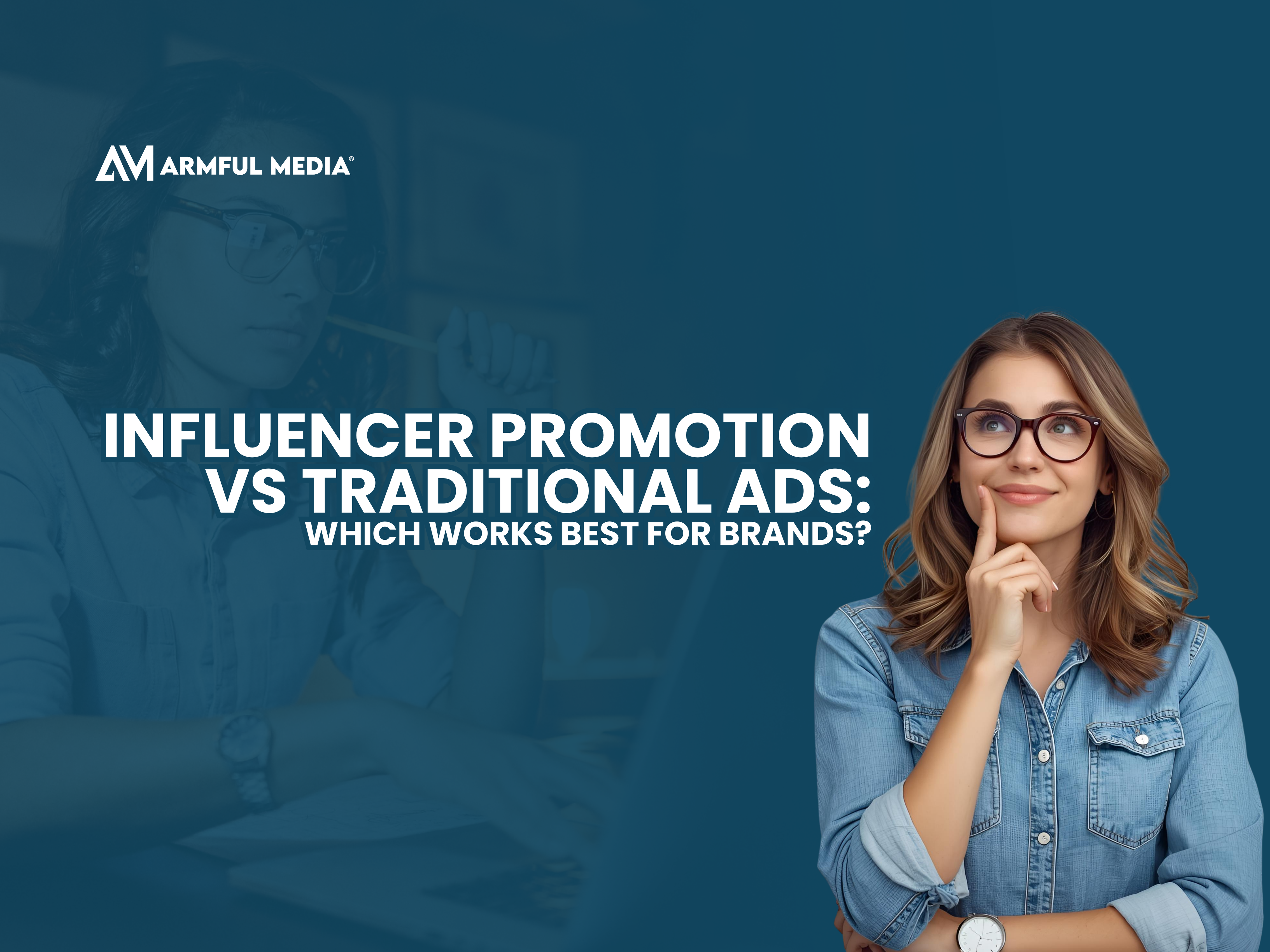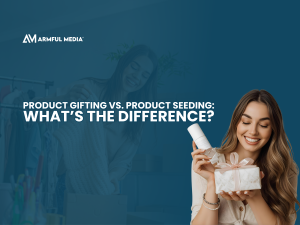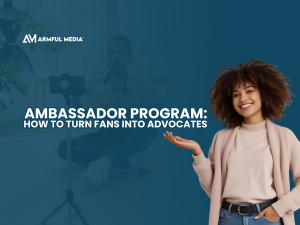Brands today are under constant pressure to figure out the best way to connect with people. Influencer promotion and traditional advertising take completely different routes. One leans on genuine voices that feel personal, while the other relies on wide exposure and polished messaging. Comparing the two helps marketers spend their budgets more effectively.
When brands understand what each method does well and where it falls short, they can make better decisions. The marketing world keeps shifting fast as digital and social media continue to grow. Traditional ads still have their place and can make a strong impact. Influencer promotion, however, offers fresh opportunities that are hard to overlook.
What Is Influencer Promotion?
Influencer promotion means working with people who already have followers online to talk about or show your brand. These influencers may post photos, videos, or stories featuring your product in daily life. Their followers see them as relatable and trustworthy rather than as paid advertisers. That trust can lead to stronger engagement and better results.
Influencer promotion is often more focused than mass advertising. Brands can select influencers whose audience matches their target market. Tracking tools help measure clicks, views, and conversions from influencer content. This makes influencer marketing measurable, adaptable, and cost efficient.
What Are Traditional Ads?
Traditional advertising uses media like television, radio, print, or billboards to spread brand messages. These ads are fully managed by the brand or agency, from visuals to timing and placement. The goal is to build awareness among large groups of people. However, not everyone reached will be interested in the product.
Traditional ads can also be expensive to produce and display, especially on popular platforms. Measuring direct sales impact can be difficult. Many brands rely on general awareness studies or surveys to understand results. Despite that, traditional advertising continues to shape public perception on a broad scale.
Influencer Promotion Vs Traditional Ads
Here are the most important ways these two strategies differ:
| Factor | Influencer Promotion | Traditional Ads |
| Trust & Authenticity | Influencers bring a personal and genuine touch. | Ads are polished but can feel distant or overly promotional. |
| Targeting & Relevance | High because brands can choose the right influencers. | Lower because ads reach many who may not be interested. |
| Control Over Message | Limited since influencers use their own tone and style. | Full control of wording and presentation. |
| Cost Structure | Flexible and scalable depending on influencer size. | High due to production and placement fees. |
| Measurability & Tracking | Easier with clear digital metrics. | Harder since results are often indirect or delayed. |
Note: Choosing between them depends on goals and audience. For large scale awareness, traditional ads may be more effective. For connection and engagement, influencer promotion usually performs better. Most successful brands combine both approaches for balance.
Why Do Brands Invest In Influencer Promotion?
Influencer marketing has become a key part of modern brand strategies. Many companies now rely on creators to connect with audiences in ways traditional advertising cannot. Here are the benefits of working with influencers:
- Builds Trust Faster: Influencers already have a good relationship with their followers who see them as real and honest people. Their product mentions sound more like friendly suggestions than sales talk. This natural tone makes audiences more open to what a brand offers. Over time, that trust often leads to real interest and stronger loyalty.
- Targets The Right Audience: Working with influencers helps brands reach people who fit their ideal customers. Each influencer attracts followers who share similar hobbies, values, or lifestyles. This focus means the message goes to those who care the most. It helps brands spend their marketing budget more wisely and see better results.
- Creates Long Lasting Content: Influencer posts and videos stay online long after a campaign ends. People can still find, share, and talk about them weeks or months later. This keeps the brand message alive without extra cost. The content keeps building awareness and interest over time.
- Offers Cost Flexibility: Brands can team up with influencers of any size, from small creators to famous names. Smaller influencers usually charge less but often have stronger connections with their followers. This makes influencer promotion fit any budget, big or small. It also lets brands scale their campaigns when needed.
- Delivers Clear Performance Data: Digital tools make it easy to see how influencer content performs. Brands can track numbers like reach, clicks, and conversions in real time. This helps them understand what works and what needs to improve. Using that data makes future campaigns stronger and more effective.
Why Traditional Ads Stay Relevant?
Traditional advertising may be old, but it still plays a strong role in marketing today. It continues to reach people who are not always online and helps brands stay visible everywhere. Here are a few reasons why many companies still use it:
- Reaches Massive Audiences: Television, radio, and outdoor ads can still reach millions of people fast. This wide exposure is useful for big product launches or national campaigns. It helps brands stay on people’s minds and build strong awareness. Few other methods can reach such a large crowd so quickly.
- Gives Full Creative Control: Brands have complete control over how their ads look and sound. Every detail from visuals to words is chosen carefully to match their message. This keeps branding consistent across all materials. It also helps protect the brand’s image and tone.
- Adds Prestige & Credibility: Being featured on TV, radio, or in major magazines makes a brand look trusted and professional. Many people see these ads as a sign of quality and success. That perception builds confidence among customers. It also helps strengthen a brand’s overall reputation.
- Stays Independent From Platforms: Traditional ads are not affected by changes in social media or search algorithms. Once an ad is placed, it keeps running with steady reach and timing. This reliability makes planning easier for marketers. It also lowers the risk of losing visibility suddenly.
- Supports Local Marketing Efforts: Local TV, radio, and billboards help brands reach people within their own area. This works well for stores, restaurants, and small local services. People see these ads while driving, commuting, or watching local shows. It builds a closer connection between the brand and the community.
What Are The Drawbacks Of Influencer Promotion?
Influencer promotion can be powerful, but it also has a few risks that brands need to watch for. Working with the wrong partner or handling campaigns poorly can hurt a brand’s image instead of helping it grow. Here are some common problems that can happen with influencer marketing:
- Risk Of Poor Fit: If an influencer’s style or audience does not match the brand, the message might not work well. Followers can tell when a promotion feels forced or fake. This can make people lose trust in both the influencer and the brand. Picking the right partner helps keep the message real and natural.
- Limited Control Over Messaging: Influencers share content in their own way, and it may not follow what the brand wants. They might focus on the wrong things or use a tone that feels off. This can make the campaign look unclear or inconsistent. Clear plans help both sides stay on the same page.
- Fake Followers & Engagement: Some influencers boost their numbers with fake followers or paid likes. These inflated stats can make their reach look stronger than it really is. Brands might end up paying for results that are not genuine. Checking influencer data and using trusted tools helps avoid wasted spending.
- Reputation & Compliance Risks: If an influencer gets into controversy, the brand can also be affected. Failing to mark sponsored content clearly can upset followers and cause backlash. These issues can harm the brand’s image and lead to trust problems. Working with professional influencers who follow the rules keeps campaigns safe.
- Audience Fatigue: Too many sponsored posts can make followers lose interest over time. People may start ignoring content that feels repetitive or overly promotional. This lowers engagement and reduces campaign impact. Posting creative, balanced content helps keep audiences interested and supportive.
What Are The Downsides Of Traditional Advertising?
Traditional advertising has been trusted for years, but it’s not without its flaws. It still helps brands reach large audiences, yet it often lacks the flexibility and precision of newer methods. Here are some reasons why it may not always be the best choice:
- High Costs: Producing TV, radio, or print ads often costs a lot of money. The process involves design, filming, editing, and buying media space, which quickly adds up. Smaller brands usually find it hard to afford these campaigns. This makes traditional advertising less flexible and harder to sustain.
- Low Interaction: Traditional ads work as one-way messages that do not invite much response. People often skip commercials or ignore billboards they see daily. Without real engagement, it’s harder to hold attention or build a connection. This limits how strongly the message sticks with the audience.
- Hard To Measure ROI: It’s not easy to see exactly how much impact a traditional ad makes. Brands often rely on general surveys or sales changes to estimate results. This lack of direct data makes it harder to judge performance. Campaign adjustments also take longer compared to digital ads.
- Weak Targeting Options: Traditional ads reach many people but not always the right ones. A big part of the audience might have no interest in the product at all. This leads to wasted exposure and less efficient spending. Precision targeting is much stronger in digital marketing.
- Slow To Adapt: Once a traditional ad is released, it cannot be changed quickly. If trends shift or new information appears, the message stays the same. This makes it hard for brands to react to market changes fast. Digital ads can adjust within hours, but traditional ones cannot.
Conclusion
Influencer promotion and traditional advertising each have unique strengths. Influencer marketing excels at building trust, engagement, and measurable results. Traditional advertising offers wide exposure and brand recognition in certain markets. Understanding how each method works helps brands make smarter decisions for their goals.
The smartest approach is often to focus on the strategy that aligns with your audience and objectives. Influencer promotion can create authentic connections and drive real engagement. Brands that understand the power of influencer marketing often see stronger loyalty and better ROI. Choosing the right approach ensures marketing efforts have maximum impact.
We can help your brand reach the right audience through authentic influencer promotion. Book a discovery call today to see how our strategies can drive real engagement and growth for your business.

The Armful Media Content Team is a group of skilled writers, researchers, and strategists passionate about influencer marketing. We create content that drives real results, engages audiences, and builds trust, helping brands expand their reach and connect with their audience in meaningful ways.








